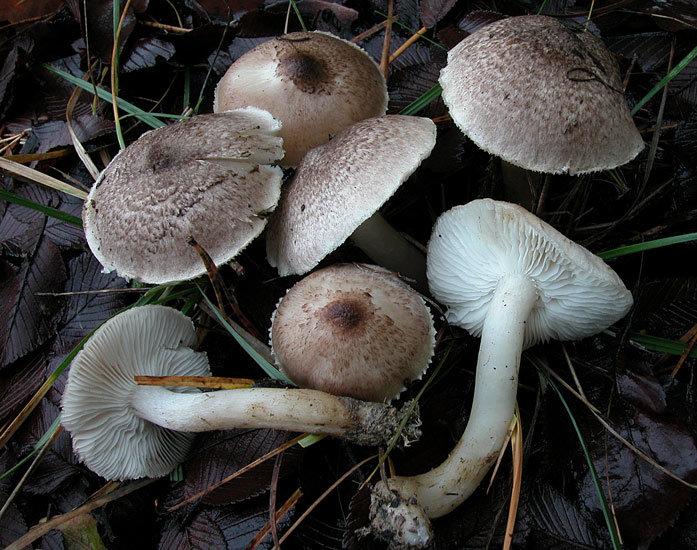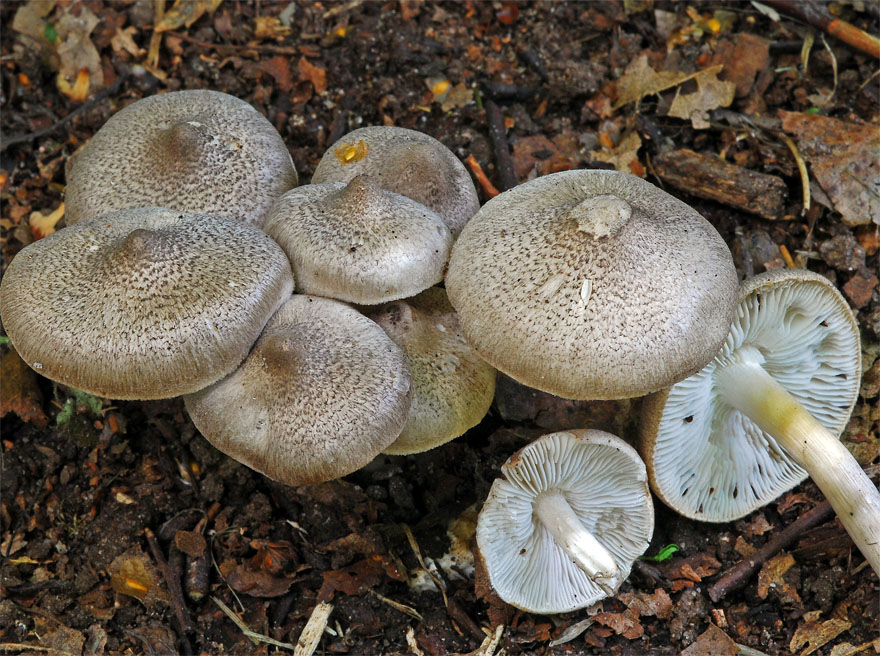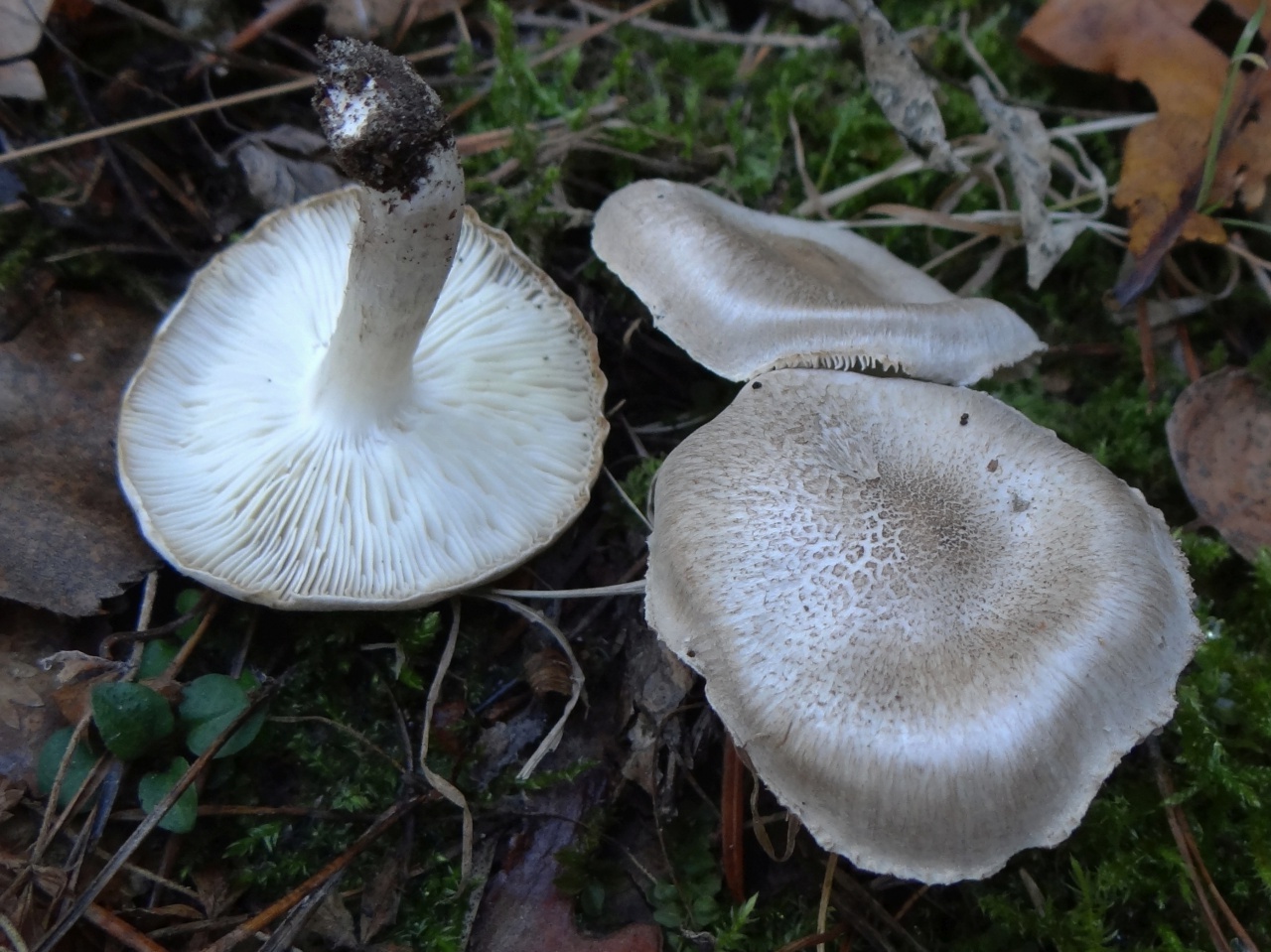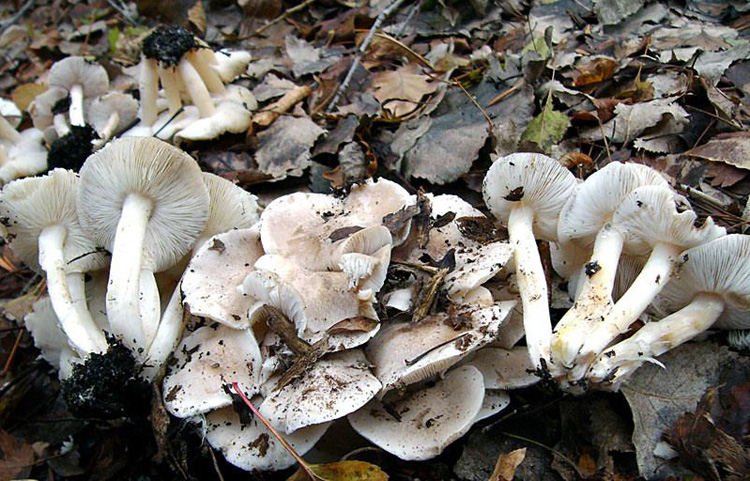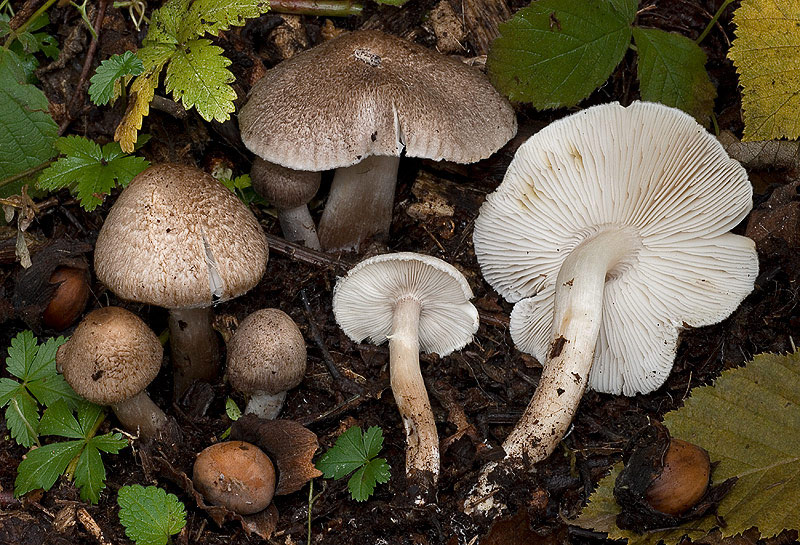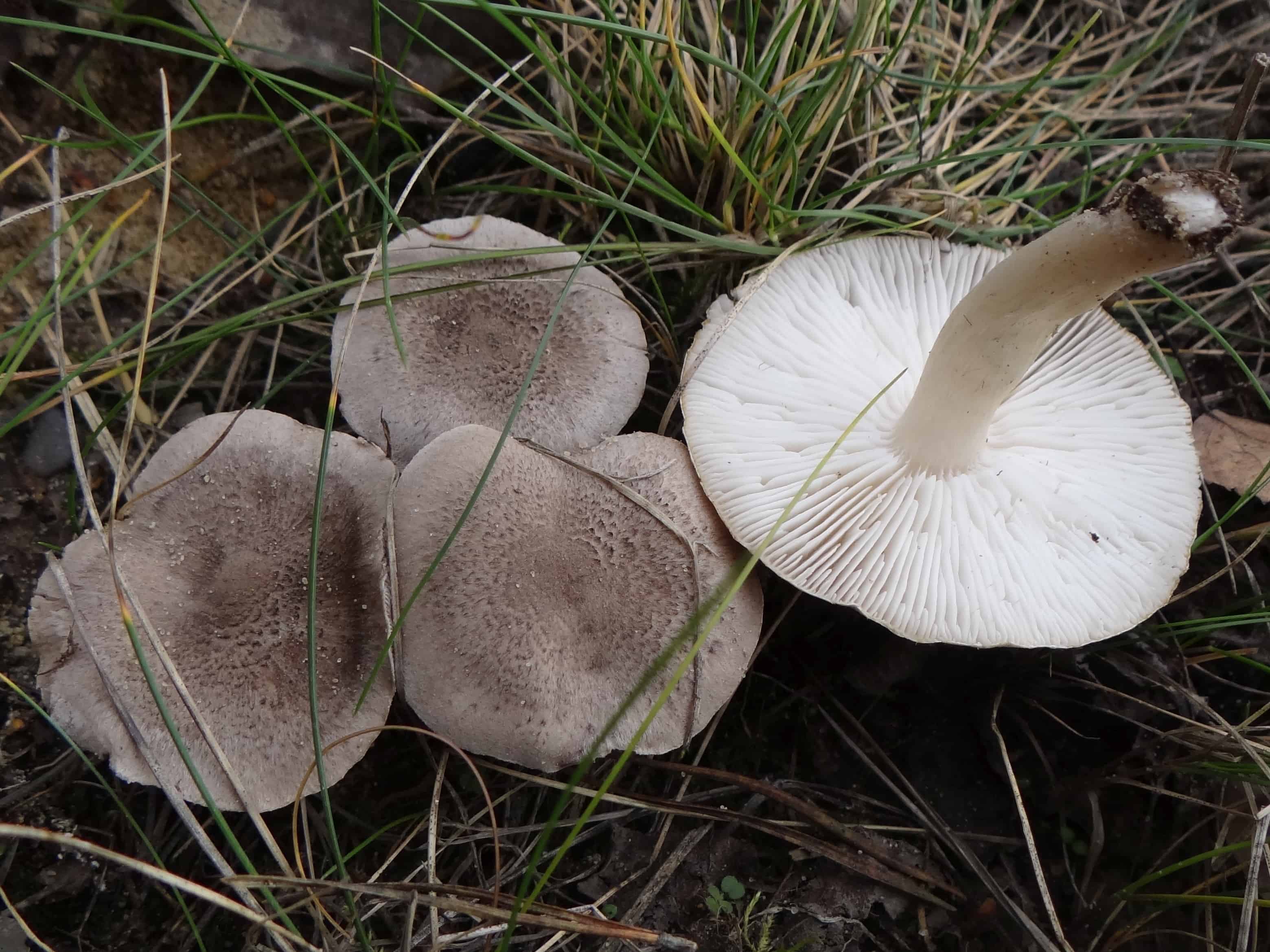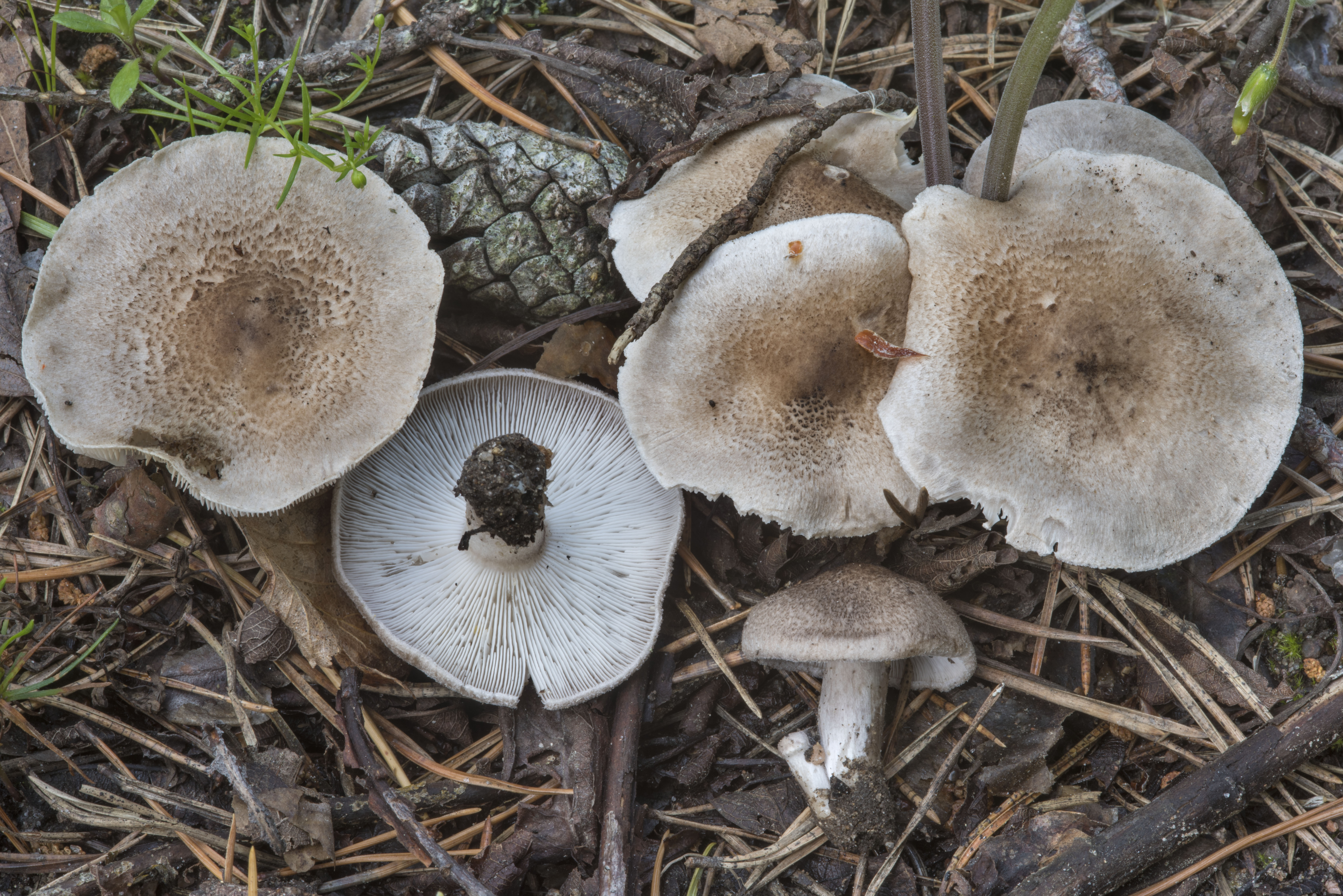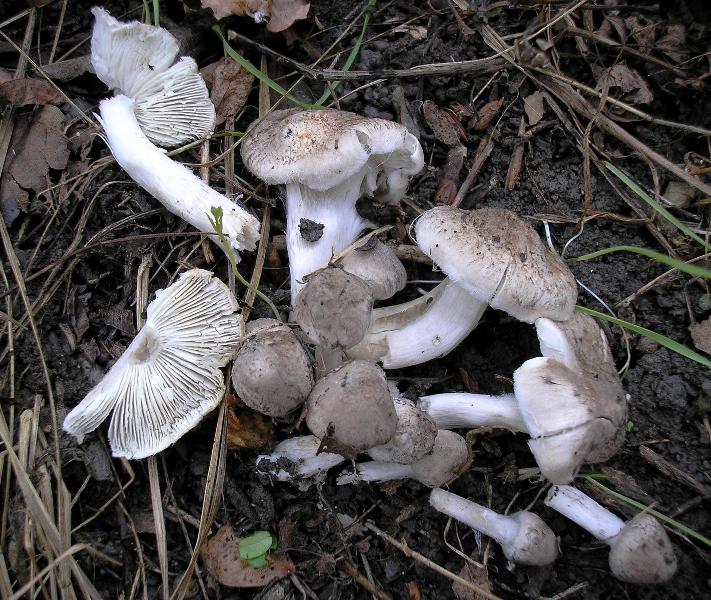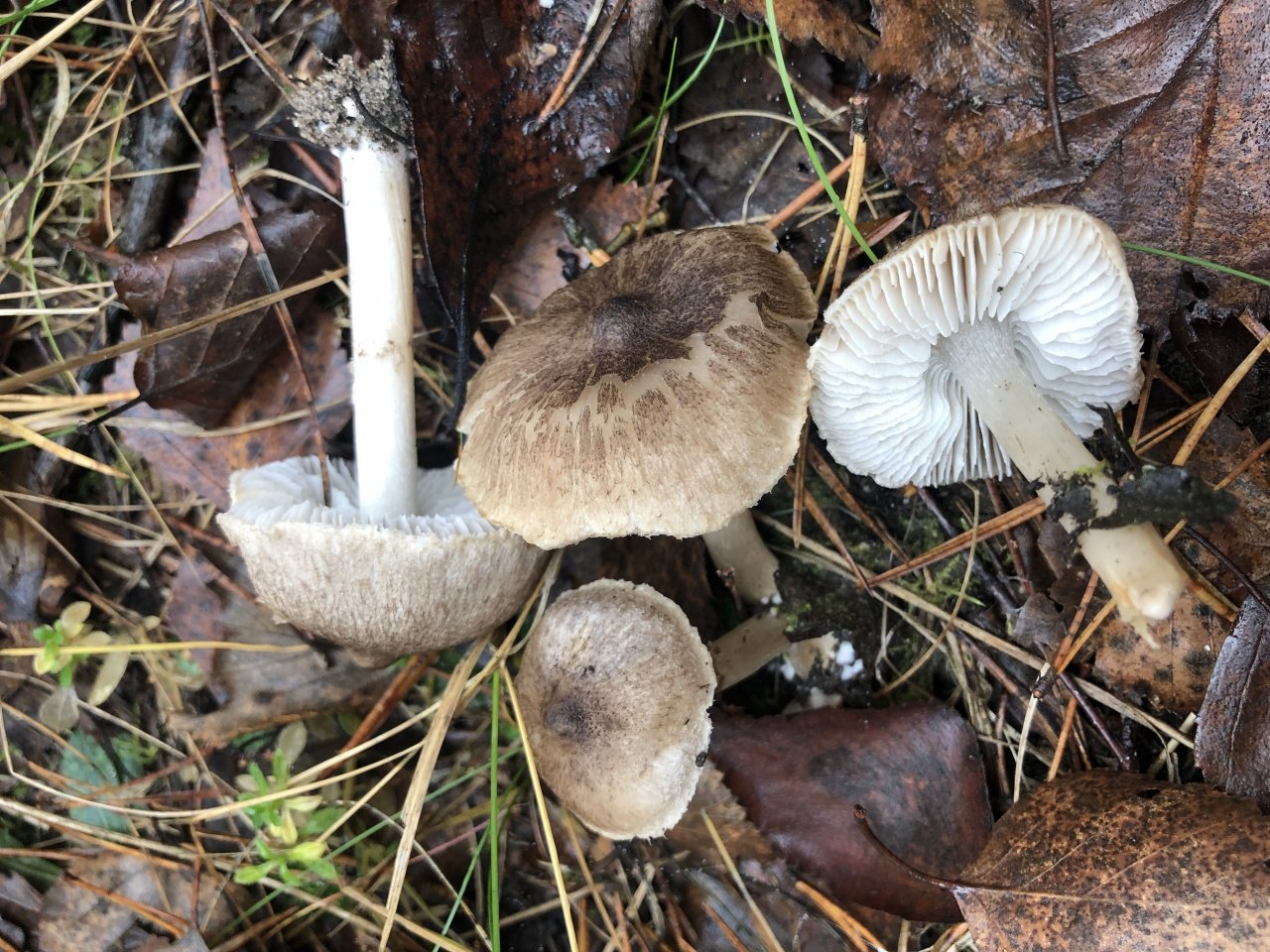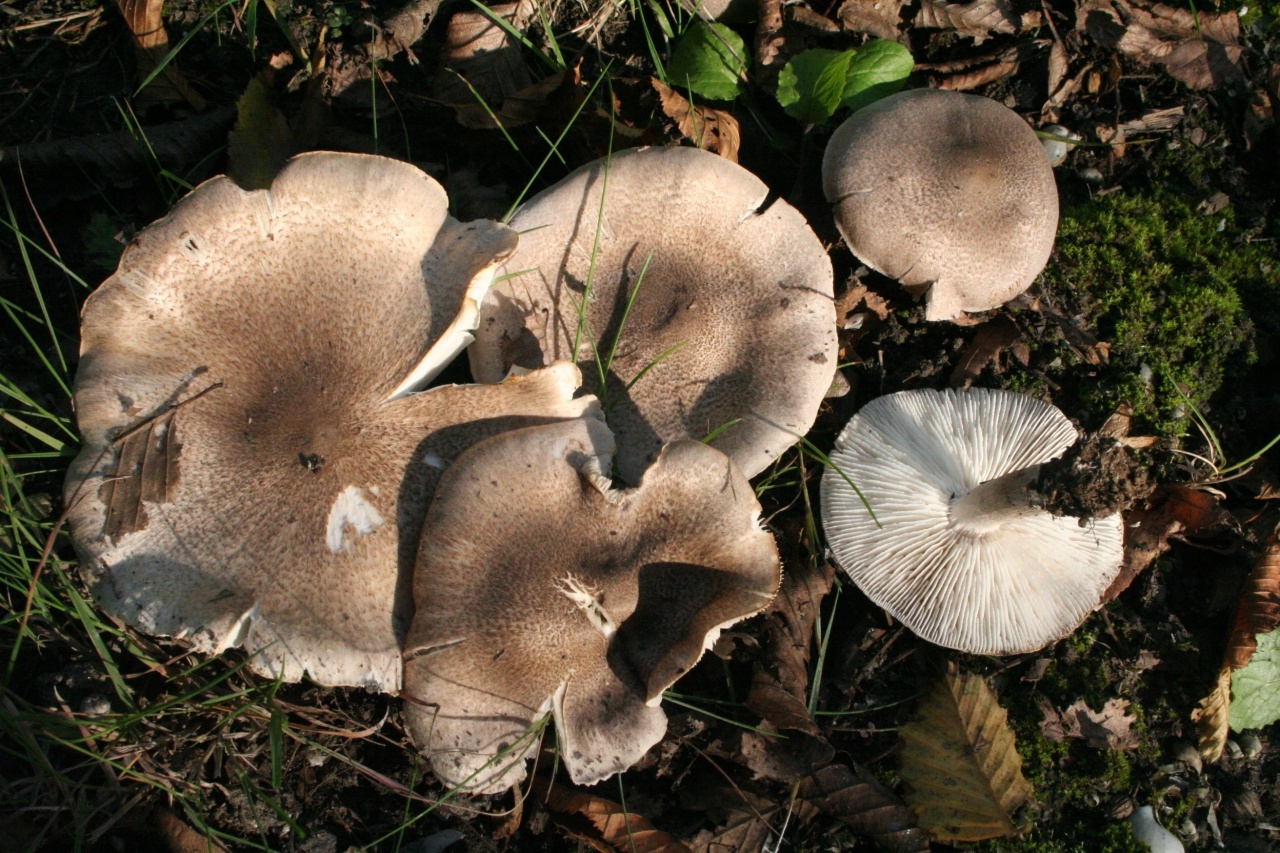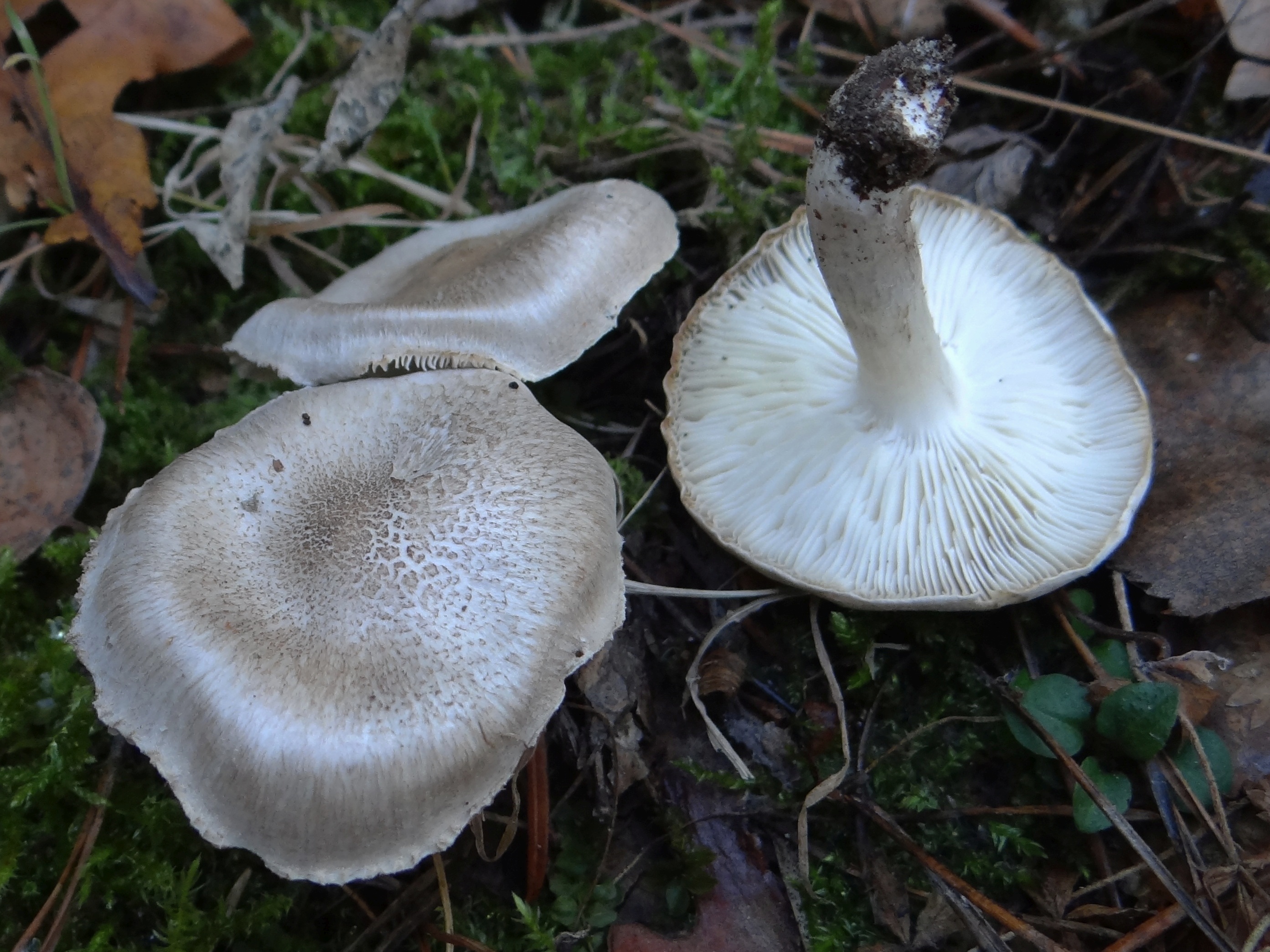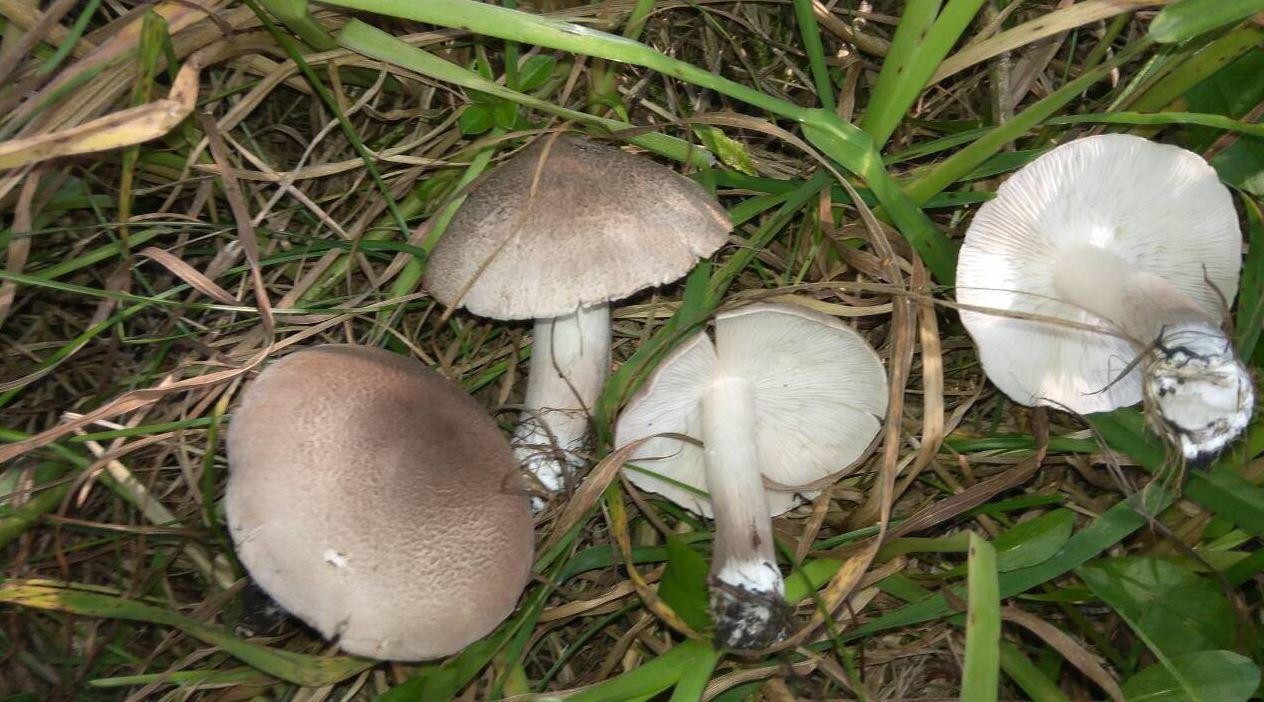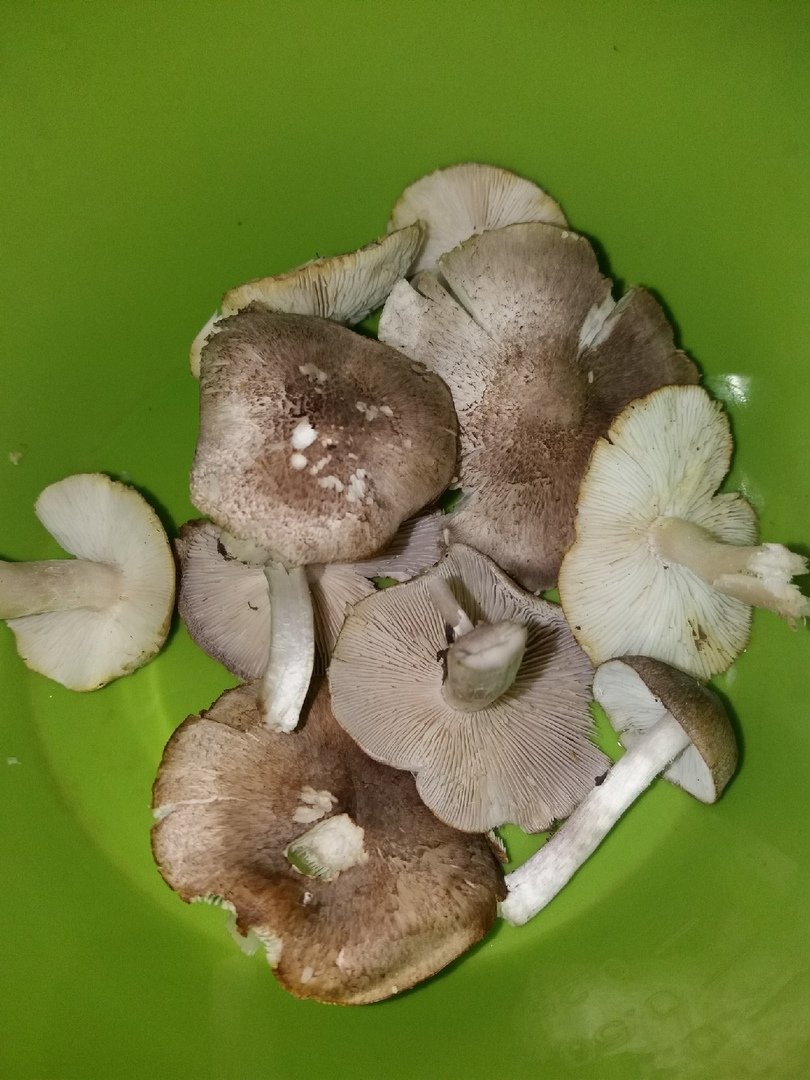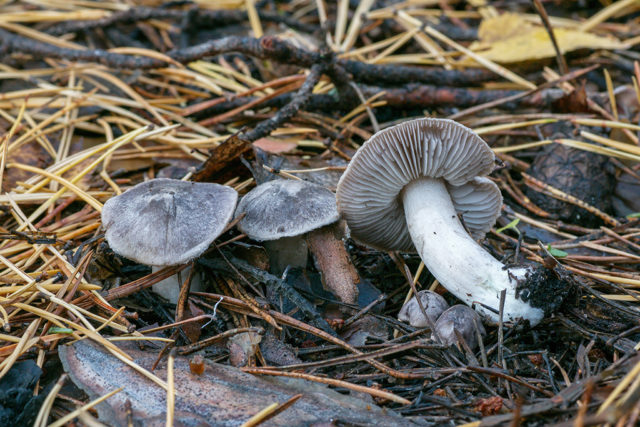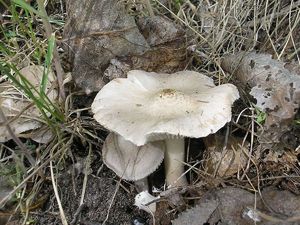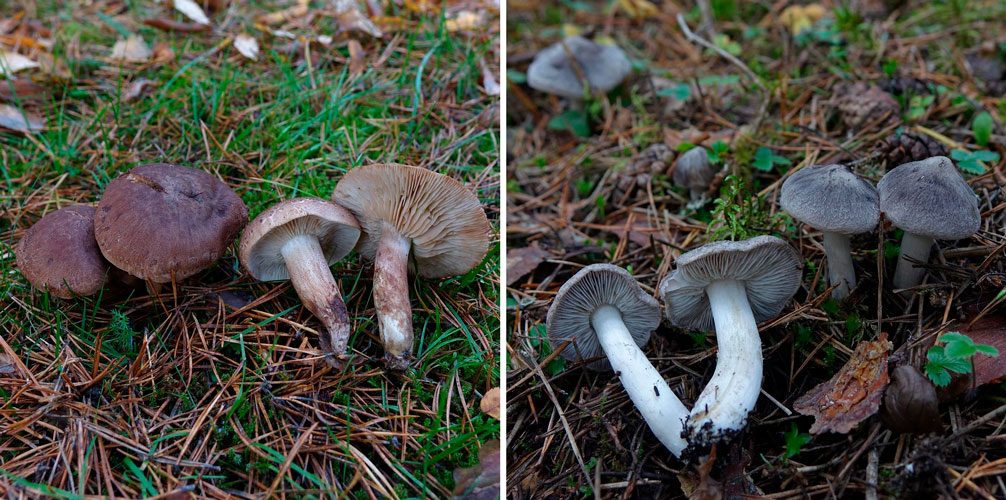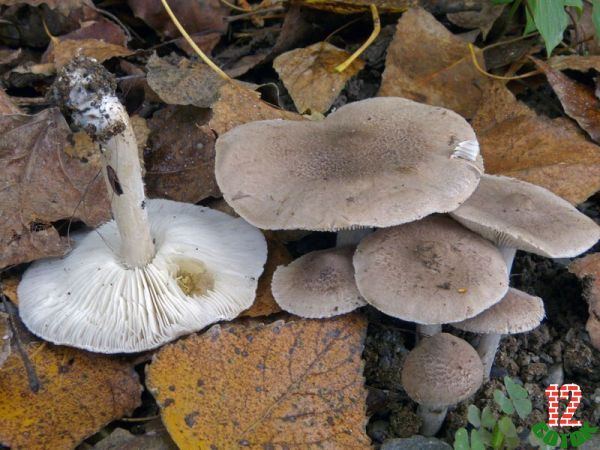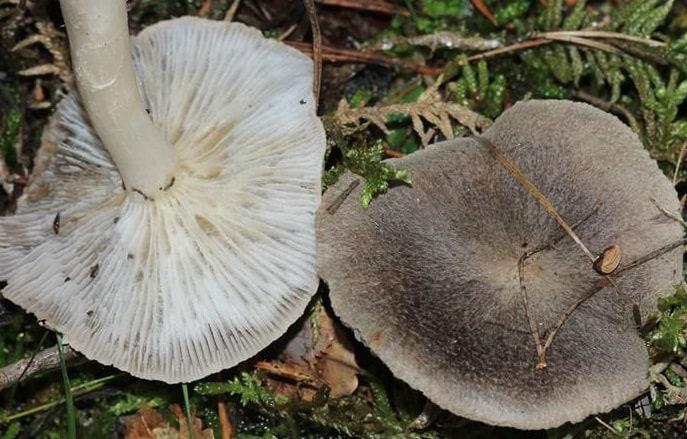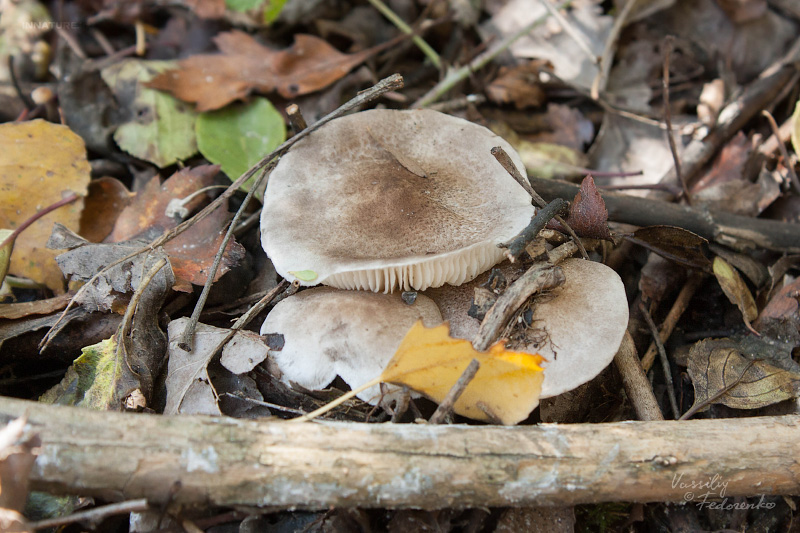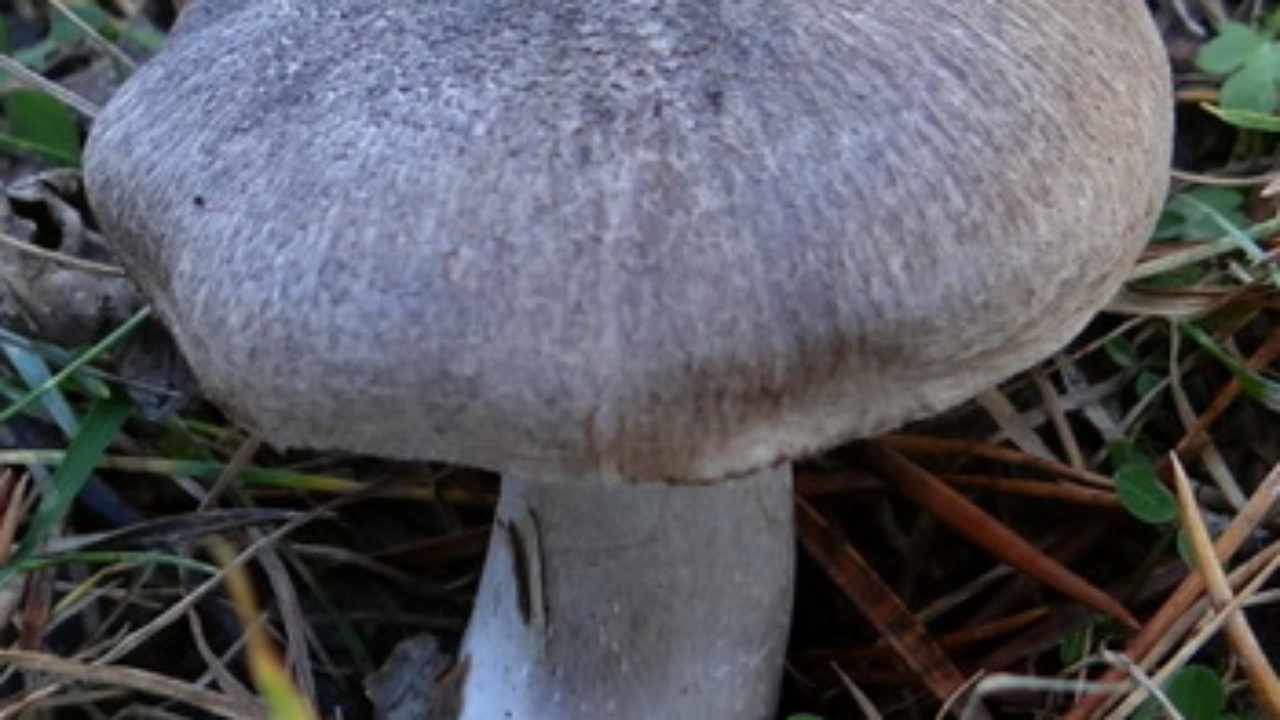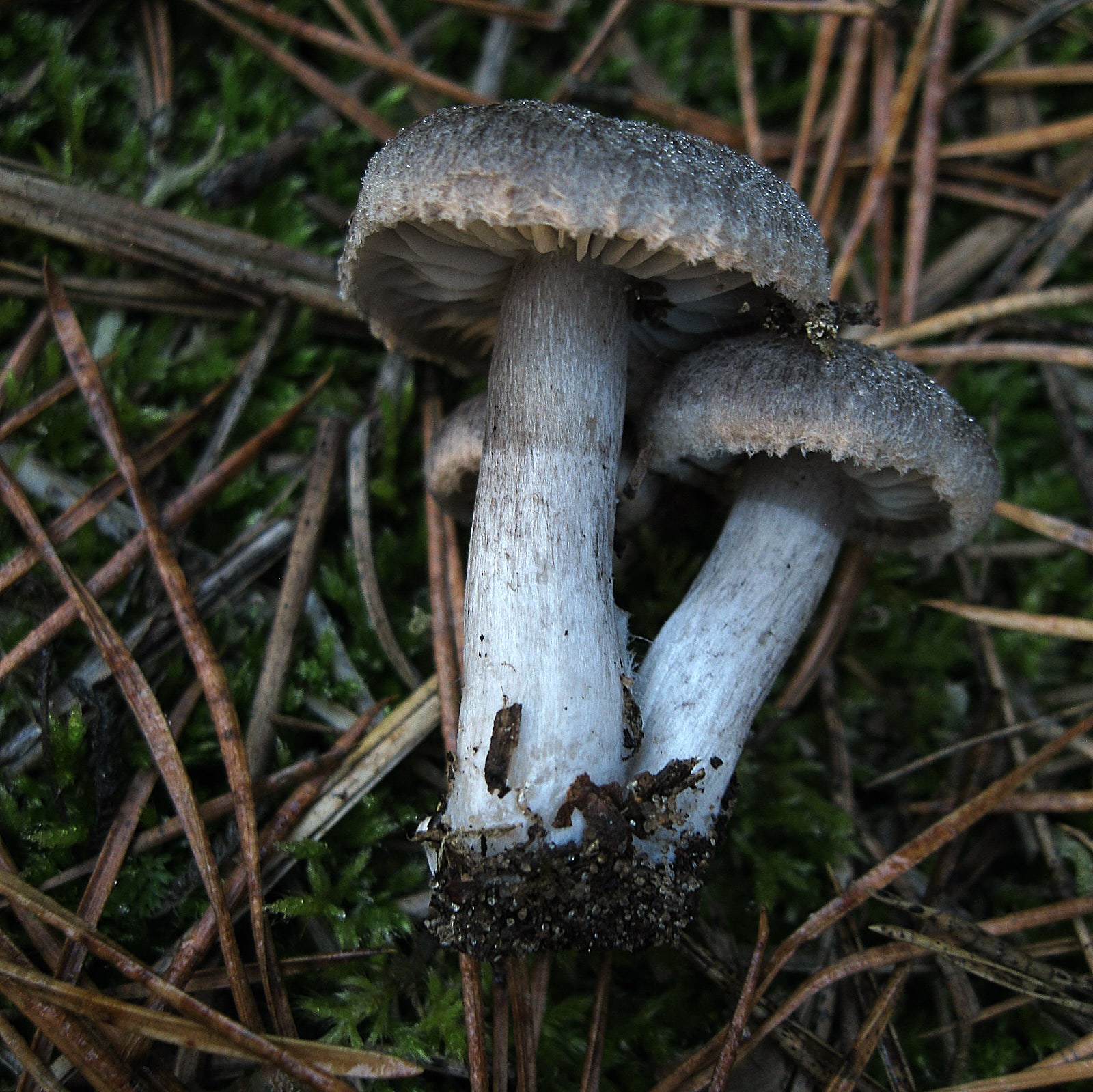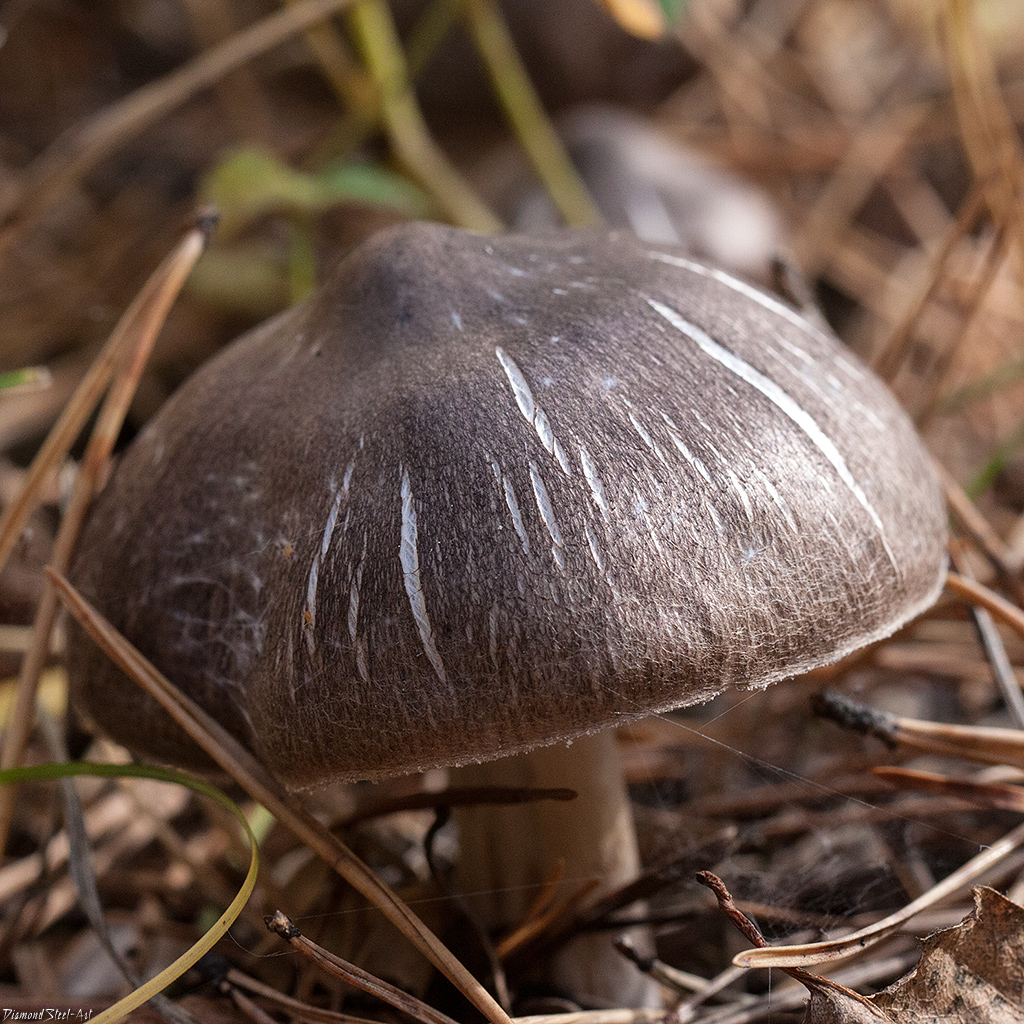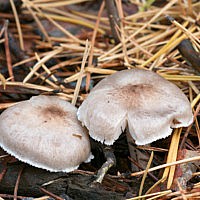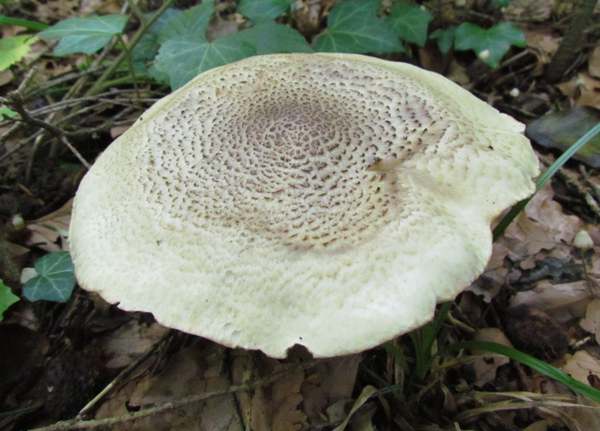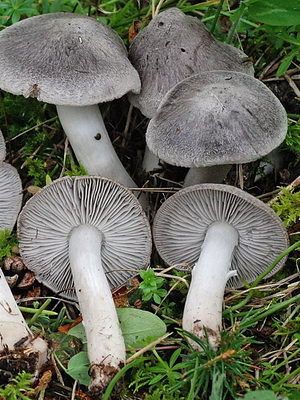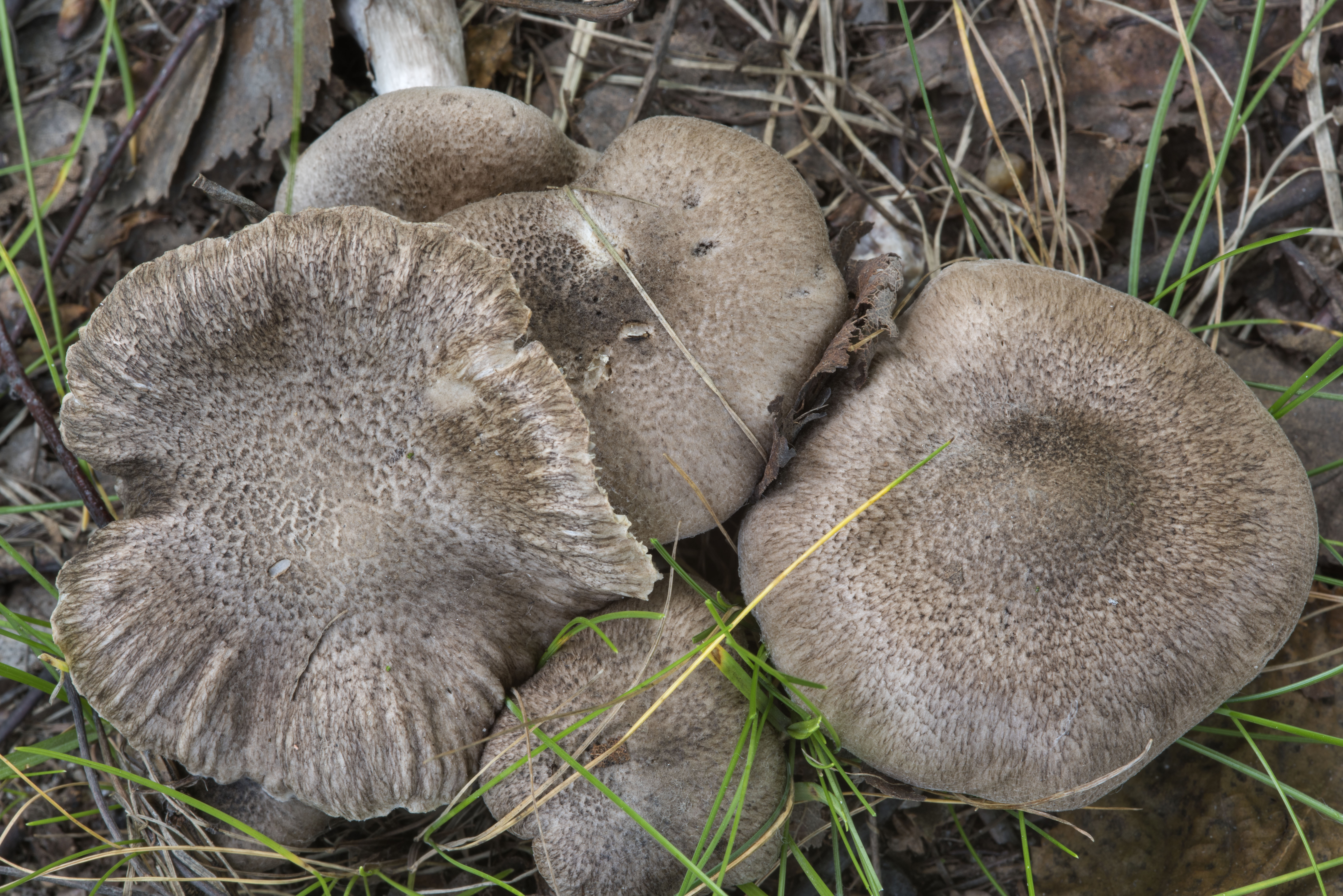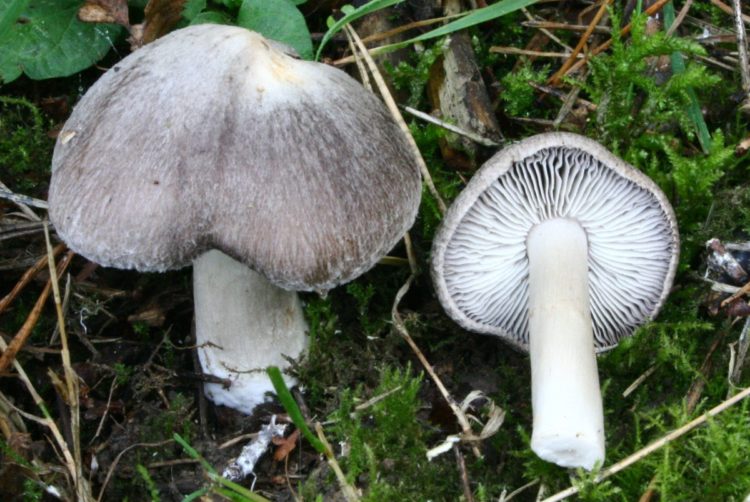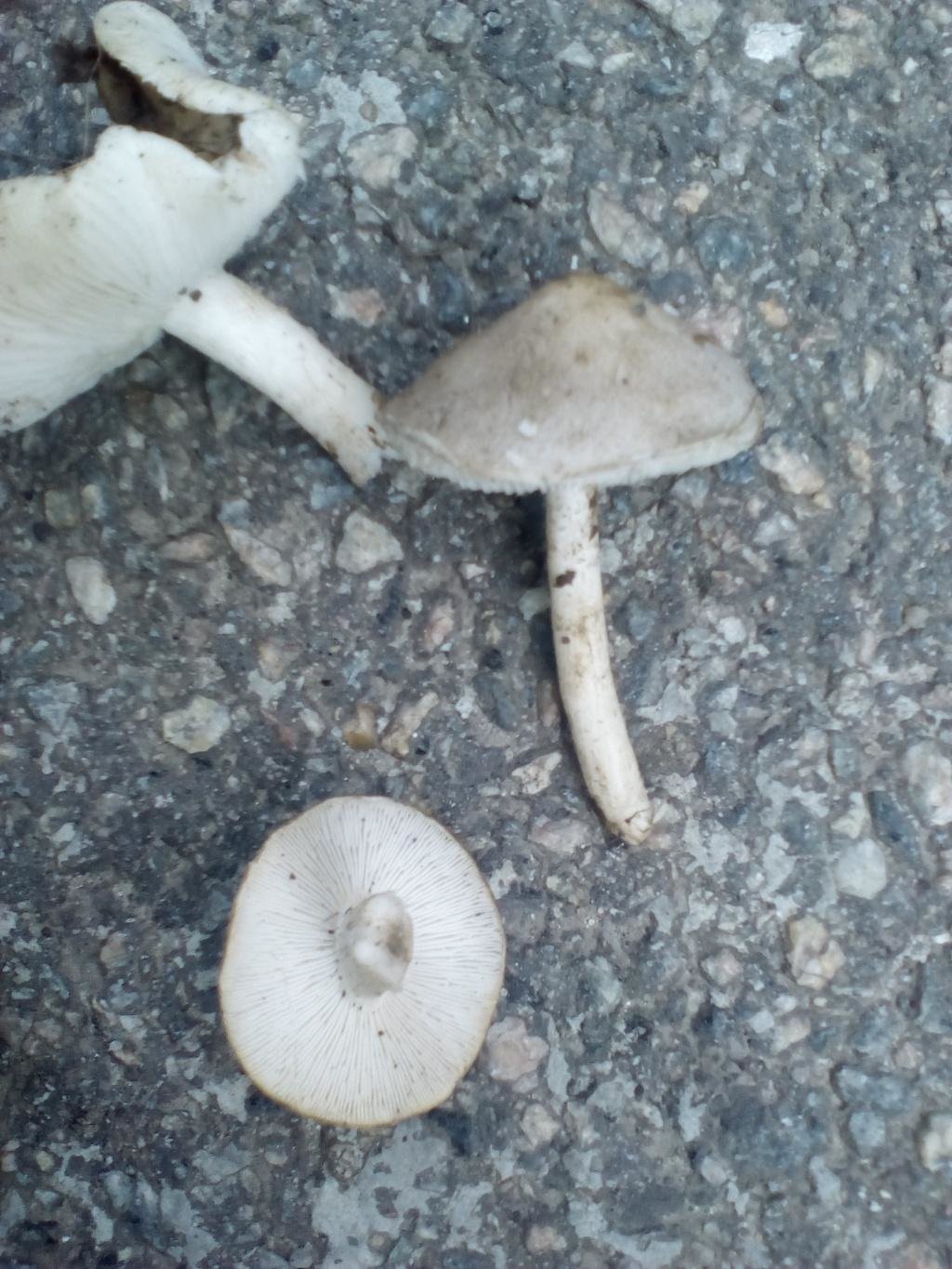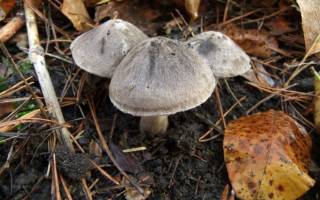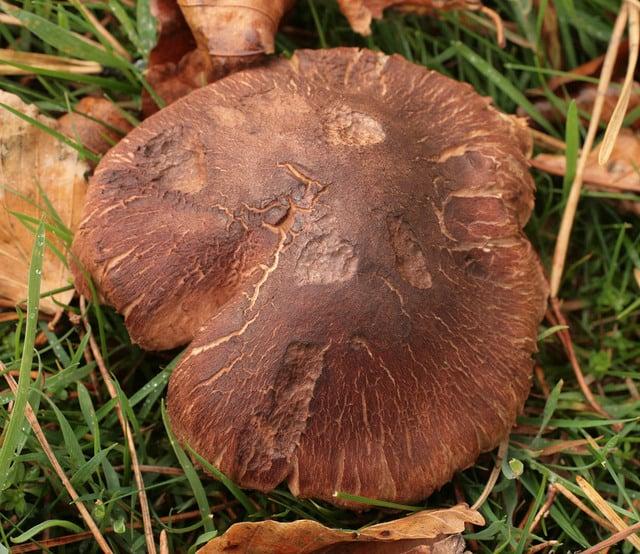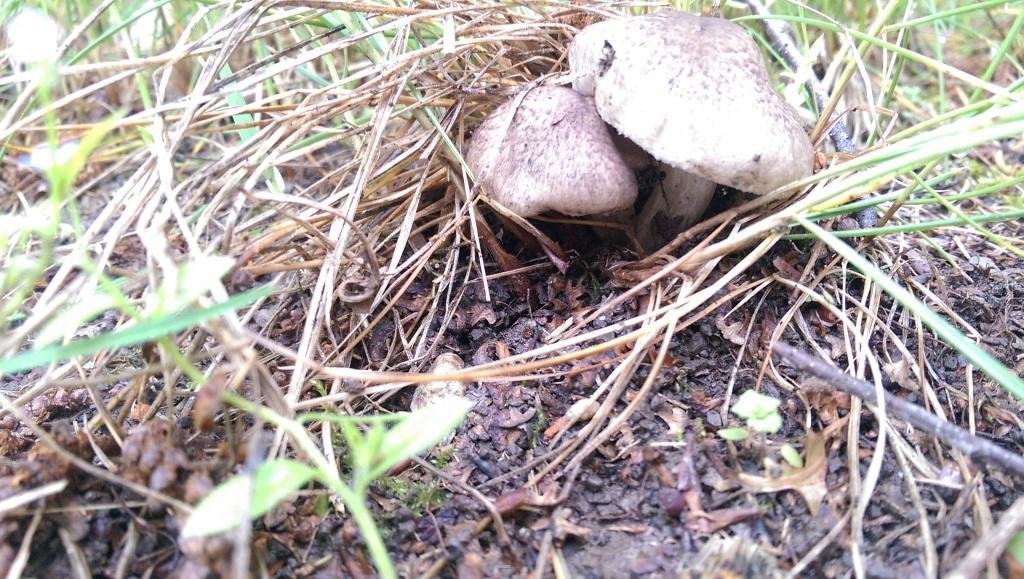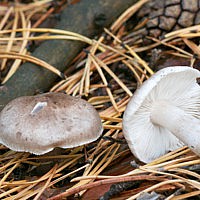Row earthy gray (Tricholoma terreum)
- Other names for the mushroom:
- Ground row
- Mice
Synonyms:
- Ground row
- Agaricus terreus
- Agaricus pullus
- Tricholoma bisporigerum
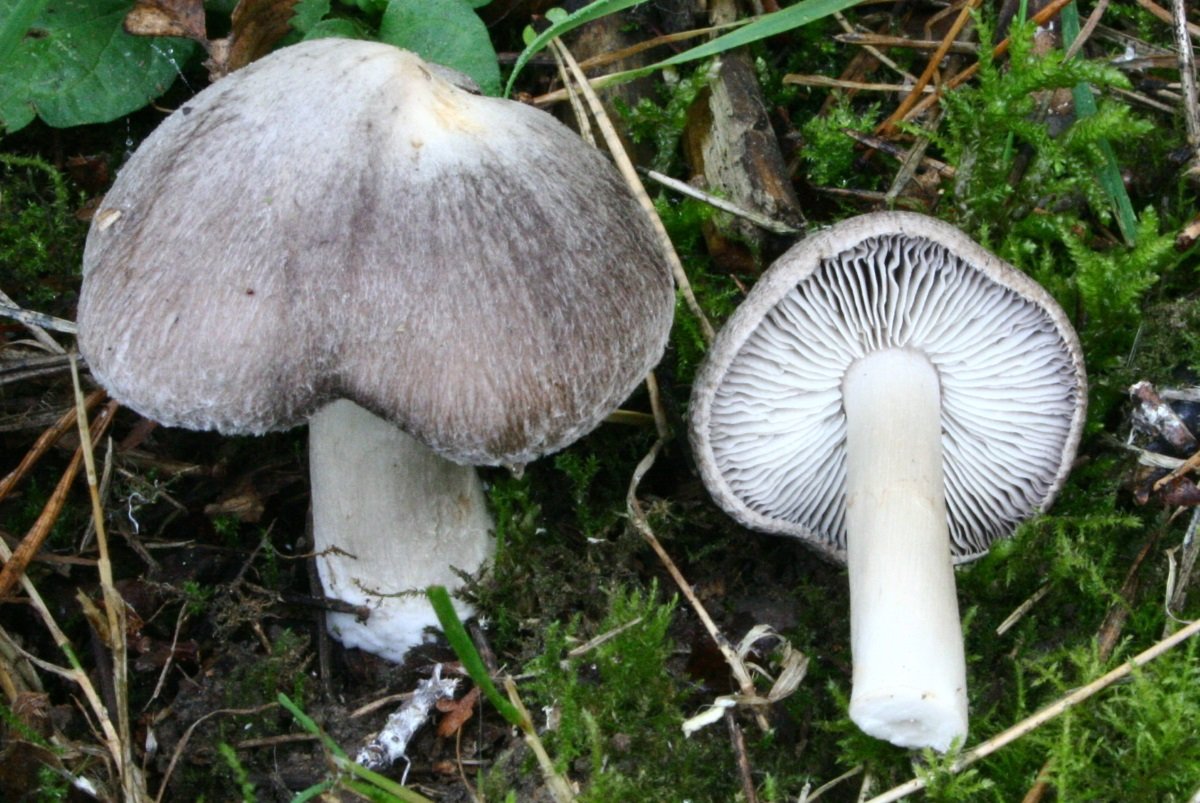
Description
Hat: 3-7 (up to 9) centimeters in diameter. In youth, it is conical, broadly conical or bell-shaped, with a sharp conical tubercle and a turned edge. With age, it is convex-spread, flat-spread, with a noticeable tubercle in the center (unfortunately, this macro feature is not present in all specimens). Ash gray, grayish, mouse gray to dark gray, brownish gray. Fibrous-scaly, silky to the touch, with age the fibers-scales diverge somewhat and white, whitish flesh shines through between them. The edge of an adult mushroom may crack.
Plates: adherent toothed, frequent, wide, white, whitish, grayish with age, sometimes with an uneven edge. May (optional) acquire a yellowish tint with age).
Cover: present in very young mushrooms. Grayish, gray, thin, cobweb, quickly disappearing.
Leg: 3-8 (10) centimeters long and up to 1.5-2 cm thick. White, fibrous, with a slight powdery coating on the cap. Sometimes you can see the "ring zone" - the remains of the bedspread. Smooth, slightly thickened towards the base, rather fragile.
Spore powder: white Spores: 5-7 x 3.5-5 microns, colorless, smooth, broadly ellipsoid.
Flesh: thin-fleshy cap, fragile leg. The flesh is thin, whitish, darker, grayish under the skin of the cap. Does not change color when damaged. Smell: pleasant, soft, floury. Taste: soft, pleasant.
Ecology
It grows on soil and litter in pine, spruce and mixed (with pine or spruce) forests, plantings, in old parks. Fruiting frequently, in large groups.
Season and distribution
Late mushroom. Distributed throughout the temperate zone. Fruiting from October until severe frosts. In the southern regions, in particular, in the Crimea, in warm winters - until January, and even in February-March. In eastern Crimea, in some years - in May.
Edibility
The situation is controversial. Until recently, Ryadovka earthy was considered a good edible mushroom. "Myshata" in Crimea is one of the most widespread and most popular mushrooms harvested, one might say, "breadwinner". They are dried, pickled, salted, prepared fresh.
However, in recent years, a number of studies have been carried out showing that the use of an earthy-gray ryadovka can cause rhabdomyolysis (myoglobinuria) - a syndrome that is quite difficult to diagnose and treat, which is an extreme degree of myopathy and is characterized by the destruction of muscle tissue cells, a sharp increase in the level of creatine kinase and myoglobin. , myoglobinuria, development of acute renal failure.
Therefore, we carefully classify the mushroom as conditionally edible: edible, provided that you do not eat more than 46 kg of fresh mushrooms in a short period and provided that you do not have a predisposition to rhabdomyolysis and kidney disease. Notes: Such popularity among the Crimean people is probably connected not so much with the high nutritional qualities of "mice" (the mushroom, according to the old classification, not the first category, but the fourth), but with the fact that "mice" is the most widespread mushroom there. In Bulgaria it is considered very mediocre, in Belarus it is rare and usually not harvested, in Russia it does not have such a resource value, although it is widespread everywhere
Notes: Such popularity among the Crimean people is probably connected not so much with the high nutritional qualities of "mice" (the mushroom, according to the old classification, not the first category, but the fourth), but with the fact that "mice" is the most widespread mushroom there. In Bulgaria, it is considered very mediocre, in Belarus it is rare and usually not harvested, in Russia it does not have such a resource value, although it is widespread everywhere.
Similar species
Row gray (Tricholoma portentosum) - fleshy, in wet weather with an oily cap.
Silver row (Tricholoma scalpturatum) - slightly lighter and smaller, but these signs overlap, especially considering the growth in the same places.
Row sad (Tricholoma triste) - differs in a more pubescent hat.
Tiger row (Tricholoma pardinum) - poisonous - much fleshy, more massive.
Curious facts
Here are some interesting facts about the rowing machine:
- these mushrooms can be grown at home, like champignons;
- in many countries the production of ryadovka is put on stream, the products are even sent for export;
- in Japan, matsutake is valued like a truffle in Europe, the price for individual pieces can reach $ 100;
- as a rule, mushrooms grow in rows (hence the name) or in circles, popularly called "witch circles".
Benefits for the body
The useful properties of the earthy row are actively used for:
- treatment of pathologies of the genitourinary system;
- normalization of the pulse rate in case of arrhythmia;
- treatment of arterial hypertension;
- fight against bone diseases (rheumatism, osteoporosis);
- treatment of endocrine dysfunction.
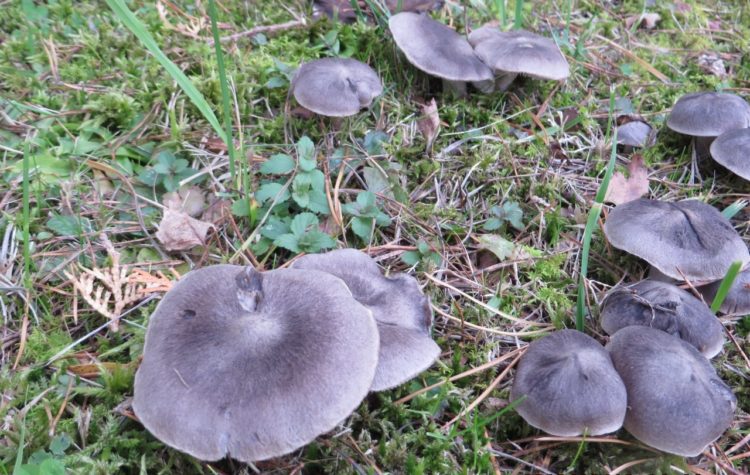
An earthy row is useful:
- in the presence of diabetes mellitus;
- with hormonal disruptions in women;
- with obesity.
Ryadovka (mushrooms), the photo of which is presented below, contains protein in its composition, therefore it is often included in the diet. Products based on it are able to completely replace meat dishes, but at the same time they are less nutritious.
Definitioner
- Basidia (Basidia)
-
Lat. Basidia. A specialized structure of sexual reproduction in fungi, inherent only in Basidiomycetes. Basidia are terminal (end) elements of hyphae of various shapes and sizes, on which spores develop exogenously (outside).
Basidia are diverse in structure and method of attachment to hyphae.
According to the position relative to the axis of the hypha, to which they are attached, three types of basidia are distinguished:
Apical basidia are formed from the terminal cell of the hypha and are located parallel to its axis.
Pleurobasidia are formed from lateral processes and are located perpendicular to the axis of the hypha, which continues to grow and can form new processes with basidia.
Subasidia are formed from a lateral process, turned perpendicular to the axis of the hypha, which, after the formation of one basidium, stops its growth.
Based on morphology:
Holobasidia - unicellular basidia, not divided by septa (see Fig. A, D.).
Phragmobasidia are divided by transverse or vertical septa, usually into four cells (see Fig. B, C).
By type of development:
Heterobasidia consists of two parts - hypobasidia and epibasidia developing from it, with or without partitions (see Fig. C, B) (see Fig. D).
Homobasidia is not divided into hypo- and epibasidia and in all cases is considered holobasidia (Fig. A).
Basidia is the place of karyogamy, meiosis and the formation of basidiospores. Homobasidia, as a rule, is not functionally divided, and meiosis follows karyogamy in it. However, basidia can be divided into probasidia - the site of karyogamy and metabasidia - the site of meiosis. Probasidium is often a dormant spore, for example in rust fungi. In such cases, probazidia grows with metabasidia, in which meiosis occurs and on which basidiospores are formed (see Fig. E).

See Karyogamy, Meiosis, Gifa.
- Pileipellis
-
Lat. Pileipellis, skin - differentiated surface layer of the cap of agaricoid basidiomycetes. The structure of the skin in most cases differs from the inner flesh of the cap and may have a different structure. The structural features of pileipellis are often used as diagnostic features in descriptions of fungi species.
According to their structure, they are divided into four main types: cutis, trichoderma, hymeniderma and epithelium.
See Agaricoid fungi, Basidiomycete, Cutis, Trichoderma, Gimeniderm, Epithelium.
- Trichoderma (Trichoderma)
-
The type of cap skin, usually consists of straight, septate elements located more or less perpendicular to the surface and laid both at the same and at different levels; the ends of the hyphae can be morphologically modified and represent dermatocystids. The surface of the cap is velvety to almost felt.
Lat. Trichoderm.
Trichoderma, in turn, is subdivided into intertwined trichoderma and irregular trichoderma.
Intertwined trichoderm (Intricate trichoderm) - trichoderm, consisting of intertwined hyphae, located not parallel to each other and forming a tomentose pubescence.
Irregular trichoderm - Trichoderma, consisting of irregularly branching hyphae.
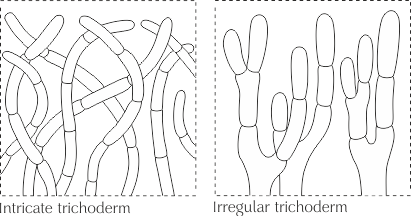
See Dermatotsistida, Hypha, Septa.
- Cutis
-
The type of cap skin, consists of creeping non-gelatinized hyphae located parallel to the surface. The surface of the cap looks smooth.
Lat. Cutis.
See Gifa.
Description of the pigeon row and differences from the white variety
Latin name:
Tricholoma columbetta.
Family:
Ordinary.
Synonyms:
the row is bluish.
Hat:
hemispherical or bell-shaped, fleshy, in diameter it can reach up to 12 cm. As it grows up, the cap opens and becomes flat, and its edges are bent down. A small bump can often be seen in the center. The surface is sticky, in young specimens it is radial-fibrous with the presence of light scales. The color of the cap is white, sometimes with pinkish or bluish spots.
Leg:
height up to 10 cm, thickness up to 3 cm, round, flat or tapering downward. The surface is silky, smooth, fibrous, dense inside. The color of the stem at the ryadovka is bluish white, and a slight bluish-green tint is noticeable at the base.
Pulp:
elastic, dense, fleshy, white in color. The smell and taste are pleasant, but subtle. Upon contact with air, the pulp of the mushroom becomes pink, and under the influence of high temperature it turns red.
Plates:
free, wide, frequent, at a young age white, and over time acquire a reddish-brown color.
Edibility:
edible mushroom.
Application:
suitable for preparing various dishes and preparations for the winter. The pigeon row is good in soups and sauces. She perfectly decorates the festive table in the form of a pickled or salty snack. The fruiting body is also dried for long-term storage. Many experienced mushroom pickers note that this mushroom gives a unique aroma to meat dishes. However, before cooking, it must be soaked in cold water and then boiled for at least 15 minutes. Both young and adult specimens are used for food. In addition, even those fruit bodies that have survived the first frosts are suitable for processing. Such gustatory qualities induce beginner lovers of "quiet hunting" by all means to study the description and photo of the pigeon ryadovka mushroom, so as not to lose sight of it in the forest.


Similarities and differences:
this species is similar to the white ryadovka (Tricholoma album) - a dangerous poisonous mushroom. However, it is quite easy to notice the differences between the pigeon ryadovka and the white variety. From the latter comes a sharp disgusting smell, which helps to determine the edibility of the mushroom.
Spreading:
the bluish ryadovka is a rather rare species in its family. The mushroom grows mainly in mixed and deciduous forests. Most often it can be seen near birches and oaks. Sometimes it can settle in pastures and meadows. Grows singly or in small groups from August to September.
Systematics:
- Department: Basidiomycota (Basidiomycetes)
- Subdivision: Agaricomycotina
- Class: Agaricomycetes (Agaricomycetes)
- Subclass: Agaricomycetidae
- Order: Agaricales (Agaric or Lamellar)
- Family: Tricholomataceae (Tricholomaceae or Ordinary)
- Genus: Tricholoma (Tricholoma or Ryadovka)
- View: Tricholoma columbetta (Pigeon line)
Row glaucous
(lat. Tricholoma columbetta
) is a fungus belonging to the Ryadovkov family. The family includes more than one hundred growing mushroom species. The pigeon row is edible and belongs to the genus of hat plate mushrooms. Mushroom pickers rarely come across.
The mushroom is decorated with a large fleshy cap measuring twelve centimeters in diameter. The hemispherical cap of the mushroom opens as it grows, and its ends are bent down.In young mushrooms, the light surface of the cap is covered with scales that match the general color of the mushroom.
The thick, dense pulp of the mushroom becomes pinkish at the fracture. It has a weak taste and smell. The tall, powerful mushroom leg has a dense fibrous structure.
The pigeon row grows singly or in small groups from mid-August to late September in mixed forests. Likes to settle next to oak and birch. Mushroom pickers noticed cases of its growth not only in the forest, but also in meadows and pastures.
This mushroom is used in a wide variety of prepared dishes. A wide variety of soups and sauces are prepared from it. The ryadovka can be grilled and dried for future use, and is also suitable for decorating festive dishes. The ryadovka cooked with meat gives the dish an extraordinary aroma. Among professional culinary experts, it is considered a very tasty mushroom with a peculiar pleasant aroma.
Before cooking, the mushroom is soaked in cold water, after which the skin is removed from its cap. Then a 15-minute thermal treatment is carried out. The row is suitable for harvesting for the winter in salted or pickled form. For cooking, both young and adult mushrooms, as well as the first frosts that have been frozen, are suitable.
Interesting Facts
Rows contain a large amount of B vitamins. Antibiotics are prepared from some varieties of these mushrooms.
The row can be grown quite easily on a personal plot, it is unpretentious, reminiscent of growing champignons.
Rows often grow in rows, which gave the name to the species, you can often see the "witch's circles" formed by these mushrooms.
Earthy ryadovka is popular in those regions where other tasty and more valuable types of mushrooms grow quite a bit. This fruit can be distinguished from its poisonous counterparts, and is also easy to grow in your backyard. Any dish will become brighter and tastier after adding these fruits.
Description of the gigantic ryadovka
The fruiting body of the ryadovka-colossus is hat-peg. The mushroom, as its name implies, is large in size. The shape of the cap is initially semicircular with tucked edges, but over time it becomes flat-convex, and then comes to open. In mature specimens, the edges of the cap rise up and become wavy.
The cap diameter of this large mushroom is 8 to 20 centimeters. Thin fibers are visible on the surface of the cap. The hat is smooth to the touch. Its color is reddish brown, brown or reddish. The edges of the cap are slightly lighter in comparison to the middle.
The leg, in accordance with the cap, is also very large, dense, fleshy, cylindrical in shape. The length of the leg is 5-10 centimeters, while the diameter reaches 2-6 centimeters. At the base, the leg becomes thicker, and its shape becomes tuberous. There is a ring on the leg. The upper part of the stem is mostly whitish, its central part is yellowish or reddish-brown, and the lower part is the same as the cap - reddish-brown.

There is a lamellar hymenophore under the cap. The plates are wide, they are often located, their color is cream, sometimes it can be pale pink. In mature mushrooms, the plates become darker - reddish-brown in color.
The mushroom pulp is very firm. The color of the pulp is white. When cut, the flesh may turn yellowish or reddish. The taste of the pulp is bitter, reminiscent of an unripe walnut, and the smell is pleasant. Spores are smooth, oval, pear-shaped, colorless. Spores form a white spore powder.
Spreading a giant row
This is a rare variety of mushrooms, but at the same time they have a fairly wide range. Within the area of \ u200b \ u200bthe range, gigantic ryadovka are found in small groups. On the territory of our country, rowing colossus grow in the Kirov, Leningrad regions, as well as in the Krasnodar Territory. They can be found in some European countries, North Africa and Japan.

Giant rows are found mainly in pine forests, form mycorrhiza with pines. They can also be found in mixed forests. They bear fruit from August to September.
The edibility of the colossus ryadovka and the number of these mushrooms
These are edible mushrooms, but they are quite rare, so it is not recommended to collect them. In addition, in some regions of Europe and our country, they are listed in the Red Book.
These rows are not cultivated. They are listed in the Red Book of the Kirov, Leningrad regions and St. Petersburg.

Other mushrooms of this genus
• Row yellow-brown - conditionally edible mushroom. Rows are yellow-brown infrequently. They grow in deciduous forests. They settle on larch stumps. Fruiting in July-September. They are found in groups of 3-4 specimens;
• White ryadovka is an inedible mushroom. They grow in large groups in dense forests, groves and parks. In appearance, the white ryadovka is similar to champignon, but it has a pungent taste and a pungent odor, which is its distinctive feature;
• Purple row - conditionally edible mushroom. These rows grow in northern coniferous and mixed forests. They settle in groups, they are found quite often. They often settle next to smoky talkers. Fruiting from September to November;
• Tied row - conditionally edible mushroom. Rowing grows tied in pine forests. Fruiting occurs from August to October. They meet singly or in small groups. Prefers mosses and sandy soils.

Portrait 2. Say a word about the poor "mice"
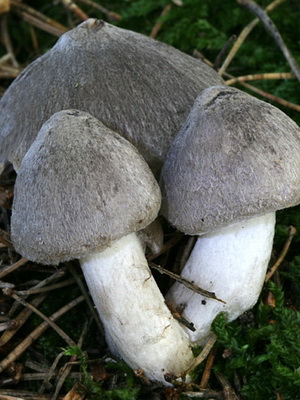
Row earthy Tricholoma terreum
If the heroes of the first portrait were mushrooms that open the mushroom season, but the heroes of the second portrait will be mushrooms that close the season. These relatively small mushrooms are popularly called "mice". And for good reason.
If you run your hand over the surface of the cap of this mushroom, you get the feeling that you are stroking a mouse. And all because the surface is fleecy-scaly. You may not notice this with the naked eye, but you can see it well in macro photographs.
And another color. Typically "mouse" - grayish, gray, brownish-gray.
And they camouflage well against a gray background. Why not mice?
But why are they "poor" - you ask. The fact is that not everyone likes these mushrooms.
They say that they are both small and fragile, and have no taste ... Of course, when there is a choice in the forest, you can hardly pay attention to mice
They begin to grow in September. And September is rich in mushrooms. But when it is already deep November and there are practically no other commercial mushrooms, then you remember about ordinary-looking mice. After all, they grow up to stable frosts.
And in good years they grow massively, densely.
And this warm winter has shown that mice, in the absence of frost, can grow all winter! At least half of the winter, for sure. This is the harvest my friend and I gathered on January 5th.
You will rarely find a single earthy row. These mushrooms love to grow in clusters. And if you find one, look for more nearby. It happens that you don't notice right away. But it is worth taking a closer look, changing the angle of view - here they are! Raking up the bedding - here's another! Friendly family!
The main distinguishing feature of mice is their increased fragility. Therefore, they must be collected carefully and must be put in a solid container. Otherwise, you risk bringing home one crumb.
And do not take overgrown mushrooms - bring porridge.
Our local mice prefer pine trees
It doesn't matter if it is pure pine or mixed forest. But the presence of the pine is a must
The most selective mice, as I have noticed, grow either among young pines or in a mixed forest. They love the neighborhood with all sorts of shrubs. For example, on January 5, we found the largest mice in a pine tree with a scumpian undergrowth.
In terms of taste, mice are far from being in the forefront among mushrooms. But their value lies in the fact that they are the last soil fungi. And sometimes the only ones. Agree how pleasant and unexpected it is to bring fresh mushrooms to the Christmas table, to breathe in their delicate mushroom smell.
Secondly, be sure to boil (not for long, just bring to a boil).In the process of boiling, debris will settle to the bottom, which could not be washed immediately. But most importantly, after this, the mice lose their fragility, become elastic. Then they should be fried until lightly golden brown. You can marinate.
Some marinate them in a mixture with other mushrooms. You can finally stew in your own juice, but not for long, about 15 minutes, so as not to allow the moisture to completely evaporate.
In a word, experiment, and maybe you will find your own, original taste of these mushrooms. And you will also bring fresh forest mushrooms for the New Year, to the surprise of your neighbors and relatives.
And yet, mice have one edible close relative, with whom they often coexist and can even grow interspersed. This is a carved row of Tricholoma scalpturatum. It bears fruit twice a year: in May-June and in autumn. Its size, shape almost coincides with the earthy row. And the fragility is the same.
But there are differences.
The hats near the carved row are lighter, often with a characteristic silvery sheen (for which it is also called the silver row), do not have hairiness, like in mice, sometimes fine-scaled, with white plates that are covered with local yellowness in old mushrooms (another synonym is a yellow row ).
This is a light carved ryadovka form that grows mainly in deciduous forests. It is not difficult to distinguish this form from the "mouse". It is more difficult to distinguish the dark form, especially when this row grows interspersed with mice in mixed pine forests.
And then it is almost impossible to distinguish the light shape of the earthy row from the dark shape of the carved row.
Who is who?
However, for an ordinary amateur mushroom picker, it is enough to know that both species are edible, that you can safely collect them in one basket to a heap, without bothering with exact identification. Let's give the analysis of all these subspecies and varieties to professional mycologists.
Description
The genus includes lamellar mushrooms with colored, less often white, caps, which in young specimens are hemispherical and convex, later flat-spread, often with a wavy, curled or bent outward edge. The surface of the cap can be fibrous or scaly. The plates are adherent to the pedicle, often with a tooth, sometimes almost free. The leg is dense, central. There is no common blanket. Occasionally there is a filmy, rapidly disappearing private veil that remains on the leg in the form of a ring. Spores are smooth, colorless. The spore powder is white, rarely cream. Many species are distinguished by a flour, or a strong and unpleasant odor. In general, tricholas are characterized by variability of external signs, which makes it difficult to determine them in the field.
They grow on soil. Many species are mycorrhiza formers (ectomycorrhizal fungi). Some members of the genus do grow in rows, sometimes very long. There are poisonous species among the rows.
Similar species
Has a dangerous resemblance. Plates of the poisonous row are darker, have a gray-green tint, a cap without a tubercle, brown with a bluish tint, sometimes gray with a steel tint. The leg of the poisonous ryadovka is covered with a mealy bloom.
Row pointed
Another inedible double. It is distinguished by an ashy shade of the color of the cap and pronounced longitudinal stripes on the stem with a tuberous thickening at the base.
Carved row
The ryadovka has an earthy-gray and edible counterpart. It is somewhat more modest in size and its pulp has a pleasant, delicate powdery aroma.
1-Row poisonous 2-Row pointed 3-Row carved
Cooking applications
This type of ryadovka is included in a variety of dishes, which include mushrooms. Previously, the earthy row must be cleaned of debris, various fragments of soil and the myceliums on the leg must be removed. If the collected specimens are slightly affected by insects, then they need to be soaked in warm salted water for at least 15-20 minutes and only then start cooking.
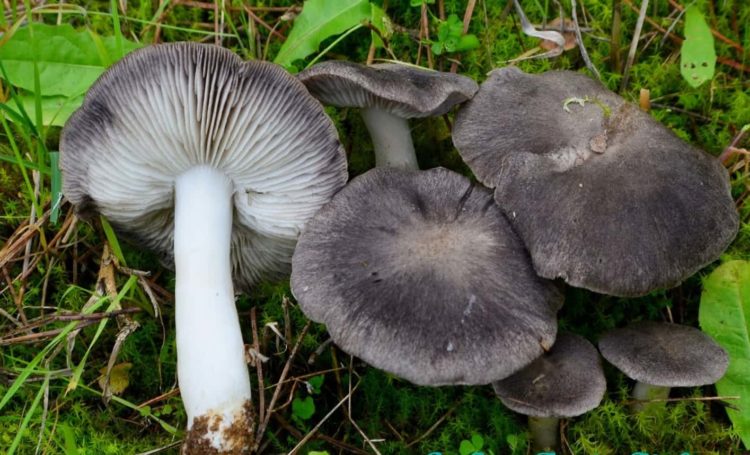
It is quite easy to prepare the following dishes from an earthy gray ryadovka:
- vegetable stew;
- light soup;
- casserole with meat, mushrooms and potatoes;
- use for stuffing pies or pies.
It is also perfectly acceptable to bake earthy mushrooms in the oven with various vegetables or fry in a pan.
The earthy row is ideal for winter harvesting. It completely retains its chemical composition after processing, and is also suitable for long-term storage. These mushrooms are used for cold and hot salting. This type of rowing is permissible:
- marinate;
- dry;
- boil;
- freeze.
Mushroom ryadovka openkovidny or bandaged (tricholoma focale): photo and description, distribution and application
A row of honeydew-shaped or tied - a very rare lamellar representative of the mushroom "kingdom", which forms mycorrhiza with pine. It is classified as conditionally edible, which means that this fruit body can be eaten after thorough heat treatment.
We suggest that you familiarize yourself with the appearance of the honeycomb ryadka thanks to the photo and description.
Description of the row of crimson (bandaged)
Latin name: Tricholoma Focale.
Family: Ordinary.
Synonyms: bandaged ryadovka, skull. Latin synonyms: Armillaria zelleri, Tricholoma zelleri.
Hat: 5 to 10 cm in diameter, sometimes up to 12 cm.
Young specimens have a convex cap, but as they mature, it straightens out and becomes convex-outstretched, and then almost flat. Sometimes fibrous-scaly, the edges are often cracking, sometimes you can observe the remnants of a flocculent blanket on their surface.
The photo shows that the bandaged row has a reddish-brown, orange-red or brick-brown hat, the edges of which are lowered down.
Leg: long (from 4 to 10 cm) and thick (up to 3 cm in diameter), cylindrical, fusiform, sometimes narrowed at the base. At a young age, the structure is hard and dense, and at an old age it becomes hollow, longitudinally fibrous.
The leg of the row of the honeycomb is shown in the photo below:
Pulp: white, dense, firm, has a weak smell of fresh flour and slightly bitter taste, sometimes completely tasteless. As for the stalk of the mushroom ryadovka honeycomb, here the pulp is fibrous. Under the skin, the pulp has a slight reddish tint.
Blades: notched, frequent, partially adhered to the peduncle, white or slightly yellowish. In young specimens, the plates are completely hidden under a fibrous cover of a reddish-brown hue. With age, this veil breaks, leaving traces.
Spores: ovate or globular, white.
Edible: conditionally edible mushroom, but abroad it is classified as poisonous. Can be eaten only after preliminary heat treatment. After boiling for 30 minutes, the broth must be drained, without the possibility of further use.
Similarities and differences: it is almost impossible to confuse with any poisonous representative. The only species that looks like a bandaged row is the white-brown row (Tricholoma albobrunneum). The latter also grows in groups, preferring pines.
However, these species have noticeable differences: the white-brown row has a very strong bitterness and an unusual two-zone, even leg. Although there is information that this mushroom is boiled and then eaten.
A photo and description of the mushroom ryadovka honeydew will help to correctly distinguish it from inedible similar species.
Application and distribution of a row
Application: applied fresh (after boiling), fried, salted and pickled. In addition, the tied row produces delicious mushroom caviar, as well as first courses.
Distribution: grows in pine forests, preferring green mosses and sandy soils. Grows in small groups or singly from mid-August to mid-October.
Some specimens can grow even after the first snows, but the weather does not allow them to ripen to the end for spores to appear. The fungus is widespread in the forests of Europe and North America.
Those mushroom pickers who are familiar with the appearance and taste of the tied row (Tricholoma Focale) note that this is a very beautiful, strong fruit body. In addition, this representative has a juicy, dense pulp that does not wrinkle or crumble.
Many people are impressed by the honeycomb ryadovka, because its structure perfectly tolerates both heat treatment and freezing. Thanks to this feature, the mushroom has a great advantage - unique crunchiness. Experienced lovers of "quiet hunting" note that it is better to use young and closed fruiting bodies.
Sometimes the smell of ryadovka is not pleasant to all "fans" of mushroom dishes, but this is fixable - you can get rid of the specific aroma with the help of spices and herbs.
Loading…
How to distinguish between false doubles of a poisonous mushroom
In the striped row, a tubercle in the center of the cap is clearly visible, it is significantly darker than the edges. The taste of the fruiting body is bitter, the smell is not pronounced, but is often noted as mealy. On the stem, longitudinal stripes are clearly distinguishable, which distinguish this mushroom from other related species.
These fruits are collected, as a rule, when there is no abundant harvest of other valuable mushrooms.
Rows are popular in Crimea, and therefore, when collecting, special attention should be paid to appearance, because the result of negligence can be very deplorable. It can only be confused with other "relatives", which for the most part are conditionally edible
How to distinguish from Gray Ryadovka?
Row gray
The most important difference is the surface of the cap. In ryadovka fiery-burning it is smooth, and in gray it is “fluffy”. In general, these fruits are as similar as possible. Another important difference is the striped leg of the poisonous specimen. In addition, the edible mushroom grows much larger, the maximum diameter of the cap is up to 15 cm.
More detailed differences between the pointed row and the gray row can be seen in the photo.

